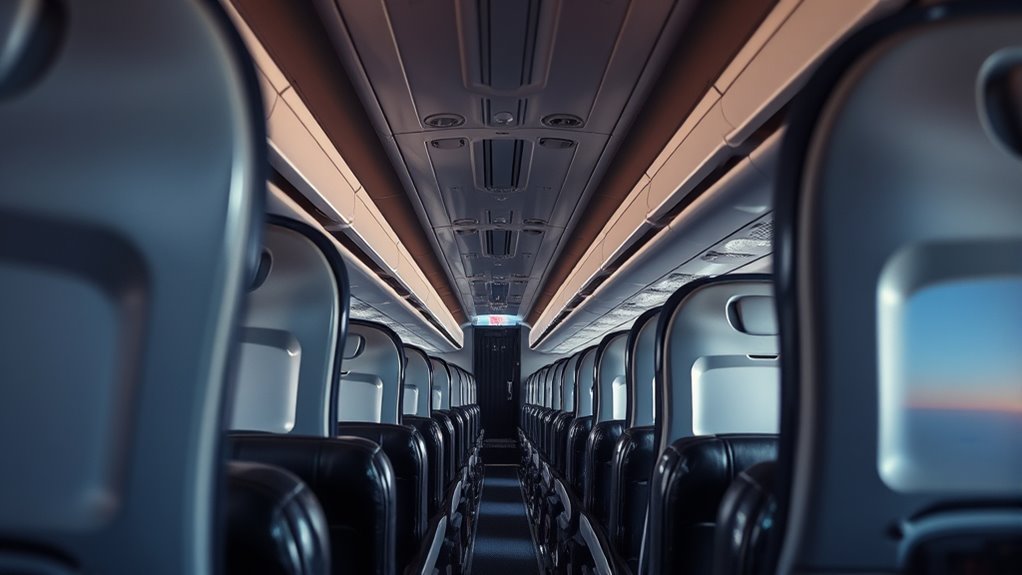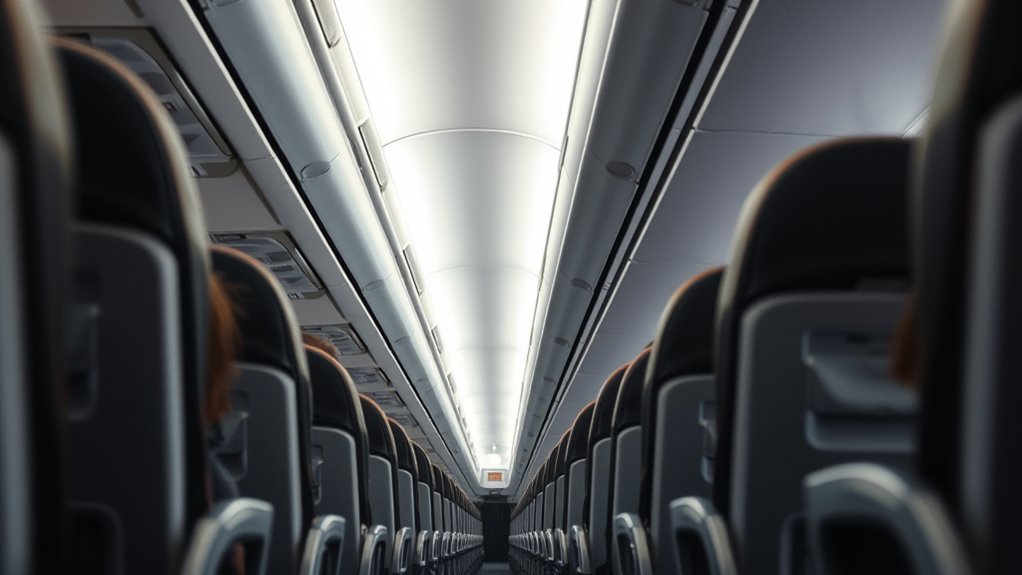Airlines keep shrinking legroom to fit more seats on each plane, which boosts their revenue without significant extra costs. In a competitive industry with slim margins, maximizing seat density helps airlines increase profit margins. They often prioritize these financial gains over passenger comfort, relying on fees and additional sales to add revenue. If you want to understand how this strategy impacts your travel experience and why it persists, there’s more to uncover about the industry’s approach to balancing profit and passenger satisfaction.
Key Takeaways
- Airlines increase seat density by reducing legroom to fit more passengers and boost revenue per flight.
- Maximizing seat capacity allows airlines to generate higher total income with minimal cost increases.
- Competitive pressures and market analysis drive airlines to prioritize profit over passenger comfort.
- Additional revenue from fees and ancillary services compensates for lower ticket prices due to denser seating.
- The focus on profitability leads airlines to prioritize seat sales over passenger experience and comfort.

As airlines continue to reduce legroom to cut costs, travelers often find themselves squeezed into tighter spaces than ever before. This trend isn’t just about comfort; it’s driven by a clear economic strategy aimed at boosting airline profits. Airlines operate in a highly competitive industry where margins are thin, and every inch of available space is a potential revenue generator. By shrinking legroom, they can fit more seats into the same aircraft, effectively increasing the number of passengers per flight without adding significant costs. This approach maximizes revenue per flight, helping airlines stay afloat amid rising fuel prices, labor costs, and other expenses. The more seats they sell, the higher their overall profitability, which benefits shareholders and keeps the airline industry financially viable. Additionally, airlines often analyze regional statistics to inform their seat configuration strategies, ensuring they remain competitive within their specific markets. However, this focus on profit often comes at the expense of consumer rights. Travelers have limited power to oppose or negotiate these changes, especially when they are presented with the choice of accepting smaller seats or opting out entirely. Airlines tend to frame these adjustments as standard industry practice, and many travelers feel powerless to challenge the trend. This imbalance underscores a broader issue: the prioritization of corporate gains over passenger comfort and well-being. While airlines argue that they’re offering more affordable fares by packing in more seats, travelers are left with less personal space, longer discomfort, and increased travel fatigue. The shrinking legroom raises questions about whether consumer rights are being adequately protected in the pursuit of higher airline profits. Moreover, airlines often rely on ancillary revenue streams such as charging for checked bags, priority boarding, and in-flight amenities. These additional fees supplement ticket sales, making the base fare appear cheaper, but ultimately increasing the total cost for travelers. This model incentivizes airlines to maximize the number of seats sold at the lowest possible price, even if it means sacrificing passenger comfort. As a result, travelers often feel like they’re paying a premium for an increasingly cramped experience, which can diminish the perceived value of flying. Additionally, customer satisfaction metrics are impacted as discomfort and dissatisfaction grow among passengers. This strategic focus on ancillary revenues demonstrates how airlines optimize their overall revenue management to prioritize profits over passenger well-being. Recognizing the importance of passenger comfort can help consumers make more informed choices, even in a profit-driven environment. In this context, airline profits are prioritized over passenger rights, and travelers must navigate a landscape where their comfort and well-being are secondary to the bottom line.
Frequently Asked Questions
How Do Passenger Comfort Preferences Influence Airline Legroom Policies?
Passenger comfort preferences directly influence airline legroom policies because you value passenger satisfaction and cabin ergonomics. When travelers prioritize space and comfort, airlines may adjust legroom to meet these demands, balancing costs and customer happiness. Your feedback and trends in passenger expectations push airlines to reconsider cabin design, ensuring passengers feel comfortable and valued. This focus helps improve overall travel experiences, even if it requires changes to traditional legroom standards.
What Role Does Airline Branding Play in Legroom Decisions?
Think of airline branding as a mirror reflecting their image. Your perception of a carrier influences their seat branding choices, which directly impact legroom decisions. If an airline emphasizes luxury, they’ll likely prioritize spacious seating. Conversely, budget brands might focus on cost-saving measures, shrinking legroom. You, as a passenger, shape these decisions through your expectations. Airlines adjust seat branding to align with their brand identity and appeal to their target audience.
Are There Legal or Safety Regulations Limiting Legroom Reductions?
You might wonder if legal or safety regulations limit how much airlines can reduce legroom. Regulatory constraints and safety standards do set minimum requirements to ensure passenger safety, but airlines generally have flexibility within those boundaries. While they must meet safety standards, they are free to optimize seat design and legroom to save costs. It’s important to stay informed, as regulations can evolve, impacting how airlines balance comfort and safety.
How Does Legroom Shrinking Impact Airline Ticket Pricing Strategies?
You might notice that shrinking legroom influences airline ticket pricing strategies by pushing airlines to refine their pricing models. As space decreases, airlines often adjust their revenue management tactics to maximize profits, offering different fares for various seat types or added amenities. This shift allows them to balance customer satisfaction with profitability, encouraging you to choose premium options or accept lower fares, ultimately impacting how tickets are priced and sold.
What Future Trends Might Affect Airline Seat Space Standards?
You might see future trends like autonomous flights and sustainable aircraft influencing seat space standards. Autonomous technology could optimize cabin layouts, allowing airlines to experiment with different configurations to maximize efficiency and passenger comfort. Meanwhile, sustainable aircraft innovations might lead to lighter, more eco-friendly planes, potentially changing how space is allocated. These advances could result in more flexible seat designs, balancing space, safety, and environmental considerations for a better flying experience.
Conclusion
So, next time you board a flight with less legroom, remember it’s all part of the grand plan to save airlines money—at your expense. Ironically, after paying for the ticket, you’re squeezed into a tighter space, all while airlines keep their profits soaring. It’s a perfect example of how economics often favors companies over comfort. Enjoy the “luxury” of your ultra-tight seat—because, clearly, that’s where your dollars are really going.
Amina brings over a decade of journalism experience to her role as Editor-in-Chief. Under her leadership, Exquisite Post has flourished, maintaining the highest standards of integrity and excellence. Amina’s commitment to truth and her visionary approach guide the editorial team in producing impactful news stories that resonate with our audience.










